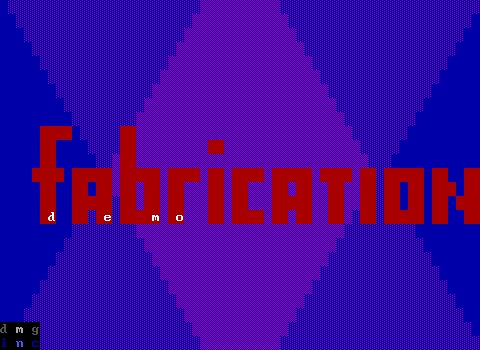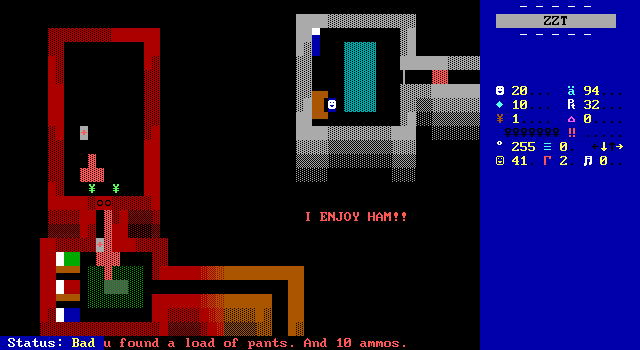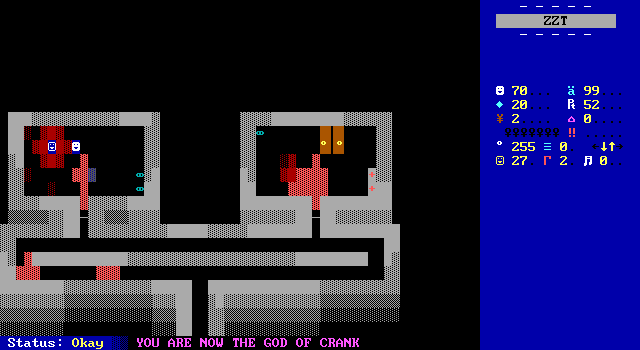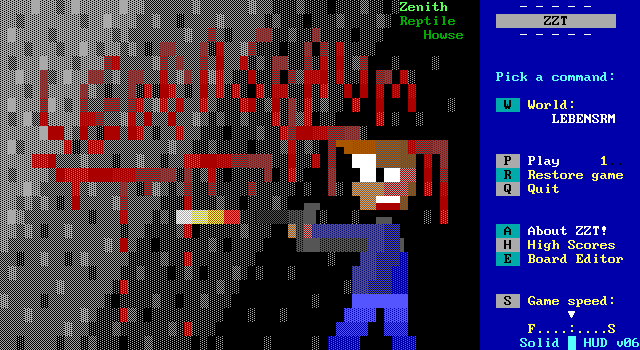
There was quite the theme going on the Closer Look poll for September. Four of the five options are late 90s/early 2000s action games. In the end though, it came down to a tie between Nadir's Lebensraum and Erik Sagen's not-turn-of-the-century-action title Captain Cosmo: The Interactive Galactic Story. Truthfully, the tiebreaker here was that I've been behind on my writing and was more willing to bet on Nadir's game to be straightforward thanks to it having a pretty strong legacy in contrast to the more recently preserved Cosmo, which could be anything in practice.
But also, I kind of wanted to see how Lebensraum holds up after all these years. Nadir's games were go-to ZZT worlds in my early teens, and I'm certain I've played it back in the day (even if it was a few years after its release), but I couldn't remember anything specific. What was more clear to me was its legacy. Lebensraum quickly became one of the most iconic ZZT action games around, thanks to its well-designed levels and the unique engine it uses to make it stand apart from typical action titles of the day. Afterwards, it became a sort of gold standard for the genre, frequently cited as inspiration for other games that sought to imitate its success, with few managing to come close.
Reich Where It Hurts
Before we actually get into what Lebensraum actually is, we should spend a minute discussing what it most certainly is not.
These days, for- *gestures at state of world* reasons, seeing a game from the ZZT community named for a part of Nazi ideology can reasonably give one pause. While even the mainstream ZZT community at its worst was more interested in shock and irony rather than genuinely espousing fascist ideology, it's not too unreasonable to fret that a historically well-regarded ZZT game might intentional or otherwise be promoting fascism in a positive way, or blundering around turning history into a tasteless comedy. Nadir's Lebensraum is not this at all. This is merely a Wolfenstein 3D derivative designed for ZZT. The plot is shoved into a single board, and from there your job is to escape from a prison fortress and ideally, leave no survivors.
There are no references to specific events of World War II, no sympathy for the Nazis, no disrespectful comments about the Holocaust. There's no cartoonish mechanical armor wearing Hitler at the end. There's not even a depiction of a swastika, with a single lone Nazi flag being rendered in such a way that you can't even tell until you read the descriptive text accompanying it. There are of course far more edgy ZZT games out there that play much more fast and loose with these symbols compared to Nadir's far more subdued approach. This is not one of them. The setting here is just a backdrop for a prison escape game with some appropriate targets. Again, Wolfenstein 3D. The part of this game that's aged the worst is that you shoot a lot of dogs that turn into red fakes, a single step up in intensity from the numerous lions, tigers, and other animals shot in countless ZZT worlds.
So please do not worry about any of that, because there's nothing of the sort contained within Lebensraum. Instead, prepare for an award winning action game that helped redefine the genre for years to come.
Jim D. Cowvitz

A main menu option for some backstory sets the scene with what's by far Nadir's best looking art board to date. Compared to the previously covered Dragon Woods, Lebensraum shows significant development in terms of Nadir's ZZT art style. Large expressive eyes never go out of fashion, but the posing here is far more complex than the paper-doll looking CATS of Dragon Woods. Unfortunately, this is the only art board until the final boss reveal, due the game being far more focused on fast-paced gameplay and not having time to stop and develop characters.
After you stabbed the guard in the chest
you grabbed for his gun....
It's 1942. The Second World War has
dragged on for what seems like forever,
and the Allies have lost France to the
Nazis. In fact, it looks as though the
Nazis are winning...
You are Jim D. Cowvitz, hard man of
action and the Allies' top man of
espionage. Just a few weeks ago you were
assigned on a top secret mission to
infiltrate a Nazi fortress where rumours
had emerged about new plans to take over
America! You got to the bottom of it and
found out the plans, but then you were
captured by Nazi troops and stuck in a
god-forsaken POW camp. The only thing you
were left with was what you knew...
All was not lost. Although all your
weapons had been taken by the Nazis as
you were taken to the camp, you found a
piece of particularly sharp, hard looking
rock in one corner of your cell...
Now you have to escape, as if you stay
in your cell now the Nazis will most
certainly exterminate you immediately.
Also, if you don't get out, America will
be taken unawares by Hitler's Blitzkrieg
invasion! So, like, escape!! Or bad things
will happen. Nyeah.
• • • • • • • • •
Jim. D. Cowvitz, "hard man of action" has utilized a sharp rock, stabbed a guard, and swiped a gun. It's a do-or-die situation for sure now as the player takes on the role of Jim and must find an exit or die trying.
It's a solid intro really. Story takes a back seat in Lebensraum, but what's here is really all you need to know. Your escape's success isn't just about saving your own skin, but dealing a major blow to the Nazis and ideally preventing an invasion of America. Once all that's out of the way, things can really begin as Jim D. Cowvitz shoots his way through three levels filled with armed guards, looting their soon-to-be corpses, and hunting down the key for the next elevator.
"Peace in our time"
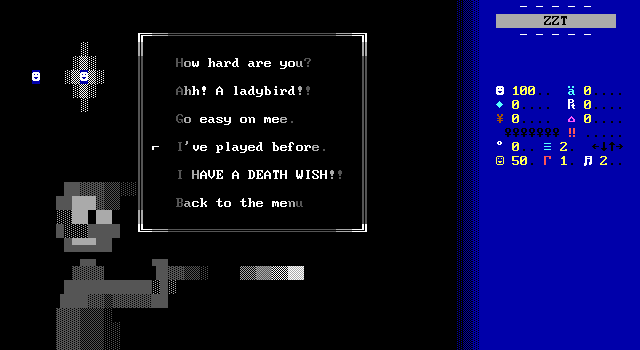
The monochromatic menus bring in the first of many clear parallels to Wolfenstein 3D. This one of a very small number of ZZT worlds that offers a difficulty setting. DinoJosh's Pirate Perils (1995) serves as an example of what that setting usually means: giving or taking ammo and health to adjust game balance, with no changes to the game world itself. I expected Lebensraum to take the same approach, but Nadir here actually goes for something more involved. Your selected difficulty actually causes certain enemies to be removed, as well as some instances where a more difficult enemy will instead be downgraded to a weaker one.
This actually gives the player some reason to return to the game and try on a harder difficultly, as opposed to Pirate Perils where starting with less health and ammo feels more like a chore than anything appealing.
Of course, this is a ZZT action game from 1999, and as such the expected flaws of this type of game are out in full force. There is going to be quite a lot of friendly fire happening here, with higher difficulties meaning more stray bullets flying around, so I doubt that the difficulty settings are actually that meaningful. Although, if you open a door that normally holds a single officer, having them be downgraded into a regular guard on a lower difficulty selection will make a difference. The extra effort is appreciated there, even if in busy firefights it won't feel all that different.
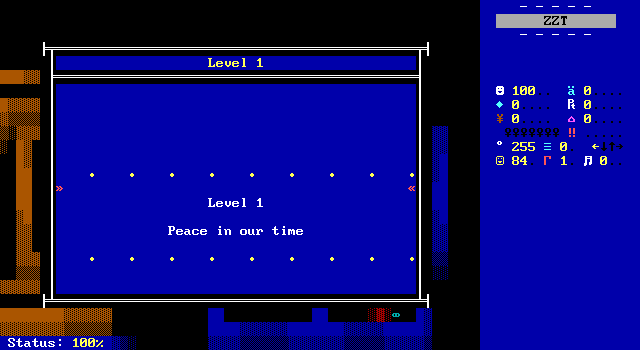
Friendly fire is the Achilles' heel of ZZT shooting. Finding reasonable work-arounds remains a challenge to this day. Nadir has a few tricks up his sleeve that help mitigate the issue, though ultimately it's a product of its time. In 1999 ZZT games were being made near-exclusively for other ZZTers who would be well familiar with the warts of the engine and far more willing to look away when such flaws showed up. Other action games at the time such as coolzx's Infestation 2 opted to keep using built-in creatures to prevent the issue. Raichu's Escape From Zyla Island shifted its focus from boards filled with guards to an endless onslaught of boss enemies, focusing on one-on-one fights instead. Commodore's far later Angelis Finale relied on increasing game speed while spacing out enemies to make dodging bullets from a distance a challenge and waiting to group enemies together too slow.
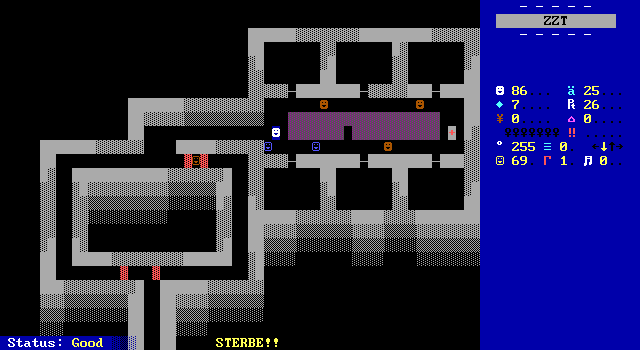
Nadir's approach is through the design of the levels themselves. He opts for (mostly) small rooms within each board partitioned off by door objects. This makes it so that when enemies do group up, they are often so close to each other that they can't actually fire a bullet off in the first place. While this does work, it also means that the primary tactic used is to open a door, and shoot from the doorway. Though admittedly, this tends to be the smart way to approach enemies in Wolfenstein 3D as well.
Patiently shooting down the hall can get tedious despite its effectiveness. Lebensraum has a few gameplay mechanics to help encourage the player to not be so shy and get out there and mingle a bit. Firstly the game implements limits on health and ammo. The player is capped at 100 health, and 99 bullets at any time. While for the first few rooms your ammo will be somewhat tight, the numbers chosen here work great. Once you inevitably leave a closet full of bullets untouched, you'll find yourself realizing that relying on friendly fire isn't necessary. Just fire off 20 bullets and come back for more later. By preventing the player from hoarding ammunition, and having to leave anything behind once you complete a level Nadir effectively gives the player a reason to engage with the enemies.
The balance on this is solid too. In more frantic moments you ammo can dip low enough that the guns blazing approach needs to be paused, but never so low that I would be afraid to keep shooting. For health, once again things are very Wolf 3D. One minute you're full, and then one bad encounter will leave you on death's door. You'll feel safe enough to keep fighting most of the time, but it's not unheard of to have to make a tactical retreat whether to a known source of healing, or a more desperate switch to exploring a different area and hoping the ratio of medkits to fascists skews in your favor.
Another benefit to risking your skin and actually moving into a room still filled with enemies is that they do leave corpses lying around. These act as walls and can be used to provide Cowvitz with cover or to create a small pocket to trap another enemy in that blindly tries to move towards the player. Touching a dead enemy allows Cowvitz to pilfer a few rounds of ammo, with the amount determined by the enemy killed. Once again this helps encourage the player to move forward rather than backwards. Thanks to the extra rounds, retreating is only necessary when low on health not ammo. The ammo the player gets back is never enough to equal the number of shots needed to kill an enemy, so Cowvitz will still need to peek into as many rooms as he can in order to keep his supplies in check.
The one aspect in which the axis has the edge over the player is in the element of surprise. This is Lebensraum's real claim to fame and what makes it stand out from other ZZT action games of this vintage. The contents of each room on a given board are invisible until the player opens the door, or in the case of some hallways, rounds a corner. In other action games, the entire board is visible at once which lets the player know where supplies are, know where enemies are, and figure out the best way to navigate the space safely. Nadir's method keeps the player in the dark (without resorting to darkness!) and adds a layer of suspense to the genre that it traditionally lacks. With no way of knowing what's behind a door until its opened every door turns into a risk assessment, especially if things aren't going so great and you're trying to run somewhere new in hopes of safety or items that will let you turn the fight around.
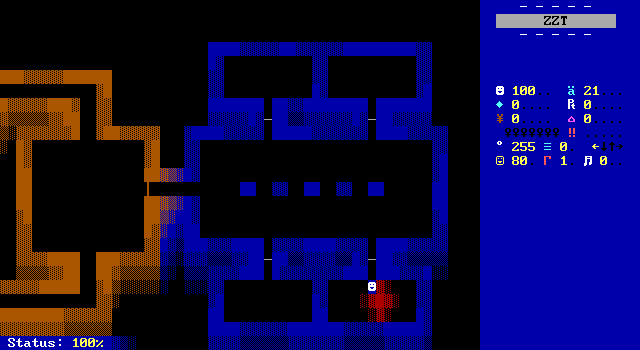
The code here goes well beyond expectations as well. Nadir could have just revealed enemies and items, the two things that affect the player's behavior towards how rooms are explored the most. Instead it applies to everything. Opening a door might reveal pillars, desks, tables, plants, radios, skeletons, or even entire carpets!
In 1999 this was all done with ZZT's default editor, so every object had to be placed with an invisible character and there was no way to reveal it for the purposes of editing in ZZT. Flip through the file viewer and be amazed at the difference between board with the objects in their invisible state and what it looks like when you change the board rendering to highlight objects in the preferences tab. The technical skill on display here alone makes it no surprise that the game became a hit, won multiple awards (Classic Game of the Month and Featured Game), and that its reviews from z2 are all overwhelmingly positive.
Lebensraum ends up being a ton of fun to play today, and a ZZT game unique in that nearly all of its flaws are not the fault of Nadir, but of ZZT's own limitations that just could not be worked avoided.
Call Reptile House Say "Aardwolf"
The Wolfenstein 3D association is no secret of course. Honestly, it's more surprising the game wasn't just named after the id Software game. There's plenty of ZZT games that used an existing property's name to tell create their own game: Quest for Glory and King's Quest being the obvious examples. Nadir would even end up releasing three conversions of Dizzy games within two months of Lebensraum's release. Perhaps Nadir saw the Dizzy games as authentic ZZT conversions while Lebensraum is creating its own levels rather than using layouts from
Or perhaps its because FPS to ZZT conversions are a notorious for being lousy. Nobody would claim Robojim's Doom is a suitable alternative to the source material. Robert Martinez's Quake is basically two boards long. Other later games based on Quake 2, Unreal, and Goldeneye didn't fare any better. If Lebensraum had called itself "Wolfenstein ZZT", it would hands down be the best of these of games by a significant margin. However, it would still inevitably fall in the shadow of its source material. As derivative as Lebensraum's design may be, it's probably for the best to take it as an original work inspired by Wolfenstein rather than a crude conversion that ZZT could never fairly compete with.
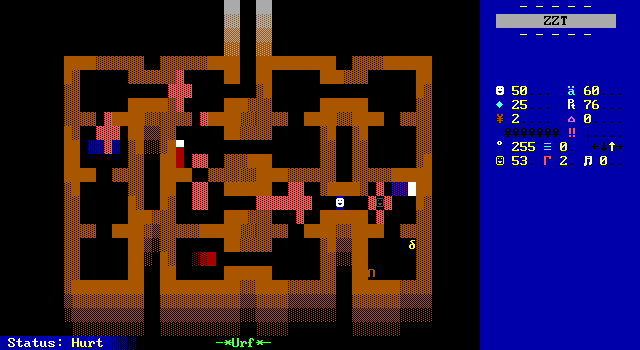
Instead, regardless of whether you've played a Wolfenstein game or not, Lebensraum can instead appeal to any ZZTer of the era, and gets to be judged by what it actually is rather than what it's trying to replicate.
The enemies are still straight out of Wolfenstein 3D, but the same can be said of pretty much every World War II themed game. You've got your typical brownshirt SA guards serving as the slow to shoot cannon-fodder. There's the tougher and more aggressive SA troops in blue that can perforate the player up close. There are trained guard dogs ready to pounce that you might actually get a chance to feel sympathy for. Lastly are the gestapo officers that wisely choose to fall back when you get too close.
In practice, most of the enemies don't behave noticeably different beyond how much ammo they drop and how many shots they take (which is always quite a bit, even the basic guards take six hits to kill). The dogs don't shoot or leave corpses so they can't be used to create cover. The SS ends up being the biggest threat as they continue to chase once they get close causing you to lose a lot of health very quickly if you don't run. It's about as basic as any other object based action game in ZZT for the time, but they get the job done. Variety in objects that move and shoot has never been ZZT's strong suit so the roster is probably as ideal as it could be. Even if the strategy to deal with them is pretty much the same always, the little touches of their distinct yells of "HALT!", "STERBE!!", "HALT, SCHWEINHUND!, and of course "VOOF!" (as they are German dogs you see). This keep things from feeling too stale as you open up each room. The very first level introduces all the enemies (provided the difficulty isn't on easy) so Nadir has to rely on creating distinct encounters with his toys rather than trying to constantly come up with something new. It's definitely preferred over "Guard", "Smart Guard", "Super Guard" levels of endless enemies with no discernible differences whatsoever.
Other hints of Wolfenstein can be found in the color of the levels themselves. Like its inspiration, Lebensraum color codes its levels to make sections more distinct. In Wolf 3D this is critical to navigate the levels from a first person perspective. Here, it's far less essential as each level fits on at most five boards. I imagine this is done more for visual variety instead of navigation, as even if you can't recall where those medkits you left behind were, once they've been revealed they'll stay revealed and just walking onto a board will be enough to know if you're in the right place or not.
Much like it's FPS ancestor, in addition to the clearly beneficially health and ammo replenishing items, there are also treasures to collect and secrets to uncover! A few rooms will just leave some golden chalices lying about, with necklaces and treasure chests being locked away for players willing to search them out. The start of the first level explains things like the limited health and ammo and mentions to keep an eye out for secrets, further cementing the comparison.
I ENJOY HAM!!
Even when the events of Nadir's games are intended to be serious, you can count on him to add little asides and jokes that always make it obvious when you're playing something by Nadir. Lebensraum has its fair share of Nadir-isms and other bits of humor added to what would otherwise be a pretty dark game. Again, none of this is making fun of the subject matter or anything. Nadir is just making sure that you don't forget that you're playing as a smiley face shooting other smiley faces until they turn into red fake walls.
Usually these kind of goofs come in the form of either silly object names, sometimes ones that go entirely unseen during gameplay. Other times, characters will realize they're speaking too seriously, and turn to all caps WHERE UPON THE PLAYER WILL REJOICE AT THE SUDDEN BREVITY. Lebensraum doesn't have much text to it, so the opportunities are a bit more rare here, but you'll find a few here and there regardless.
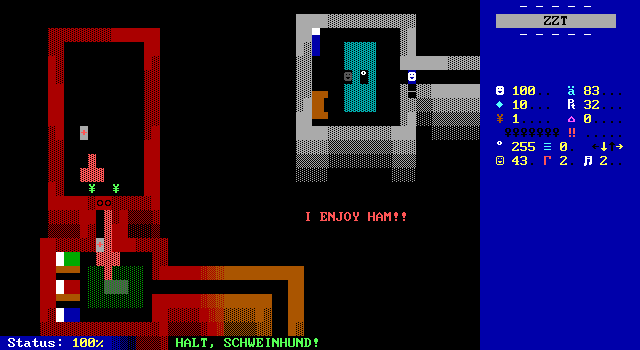
The strangest of which is definitely here where "I ENJOY HAM!!" appears in the middle of the board after enough time passes. For me, it happened the moment I touched a plant and I thought it was a bizarre Easter egg, but no, with the way this board requires multiple trips I can't imagine anybody not getting to see this ham commentary.
That same board contains a searchable desk with... pants.
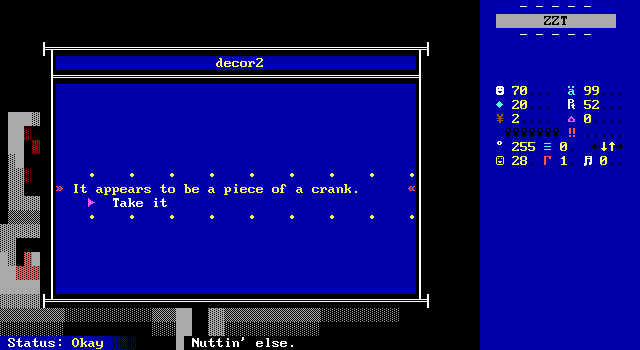
Every room in the game is either unlocked or inaccessible. Keys exist solely to access the elevator to the next level. The only exception is one room which requires a crank to open the doors to and produces this message when it's picked up. Granted, I can't specifically give the credit to Nadir on this one. There being a ZZTer by the name craNKGod meant that actually a lot of ZZT games will invoke his name when a crank needs to appear, a surprisingly common occurrence, that probably showed up even more often for the opportunity. I mean, I will still be reminded of craNKGod whenever there's a crank in a video game to this day. Picking up the crank even sets the flag "crankgod".
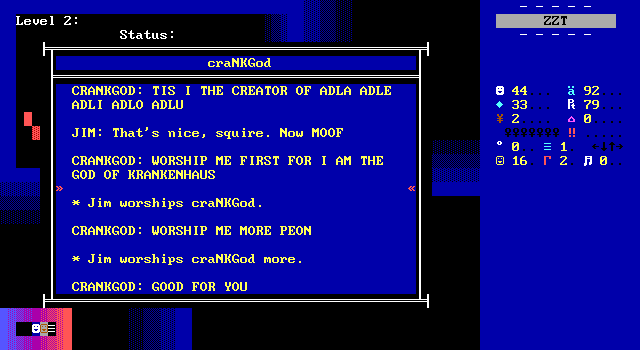
At the end of the first two levels, Nadir gives the player a break which is also used as an opportunity to cameo a different ZZTer. Unsurprisingly, this includes craNKGod with Jujubee showing up earlier.
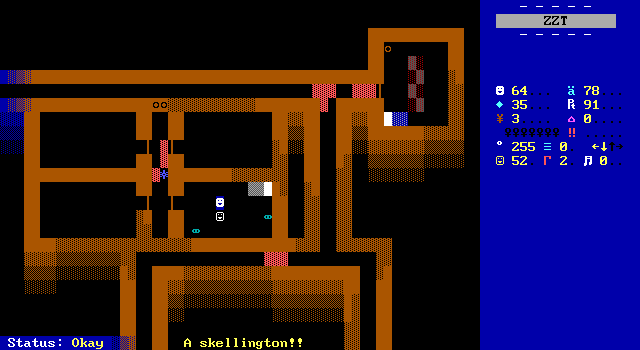
The whole prison fortress thing means that there are plenty of human remains lying around in certain rooms. More than a few skeletons appear, but this one gets its own special message.
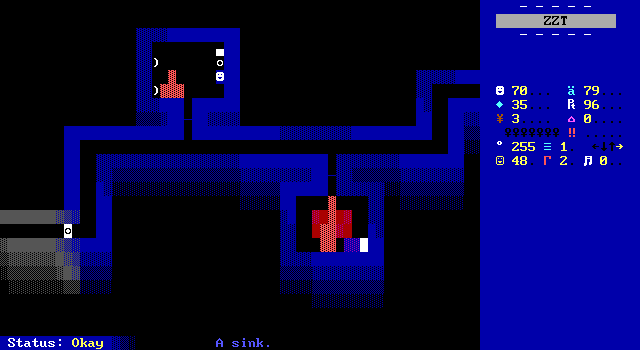
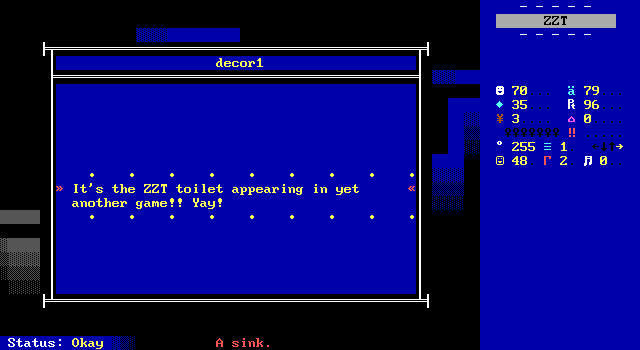
As if almost having forgotten, the very last room before the final boss is a bathroom complete with sinks, toilet, and a guard who got the Jim when they wanted the John.
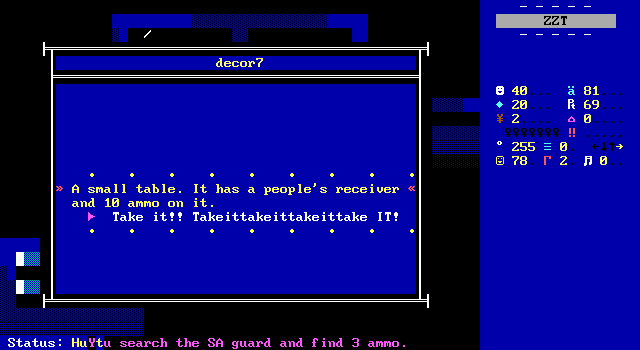
Okay this one is just a Simpsons reference, but hey it also got me to learn about people's receivers. Oddly this is also the only instance in the game that seems to be leading to developing the story in some form. Despite acquiring a radio, the player doesn't get a flag set or bonus points or anything at all for taking the device. I mean, I get that it's only a receiver, but surely a few important communications could be intercepted, even if it's just to set up that the final boss is on their way to deal with this escaped prisoner.
Polish Power

No no, I mean the extra care that makes Lebensraum shine, not this z2 forum emoji.
First, the basics. Things Nadir gets right that aren't surprising that he would, but that other ZZTers making games of lesser quality might get wrong.
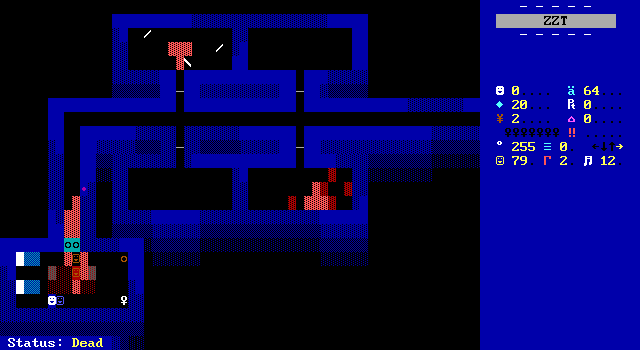
Lebensraum has the requisite gore you'd expect from any ZZT action game where the violence is meant to be in some way realistic. People are being shot, and they bleed all over the place when killed. This is pretty typical stuff. Nadir is wise enough to not blindly spill blood around and properly checks for unoccupied spaces first. There's no worries about accidentally having a critical object be replaced with a red fake here.
Similarly, Nadir also let the player clear out the bodies. Most ZZT foes vanish entirely when killed, but in games like this one where there's a reason to check the corpses to replenish ammo some might make the mistake of letting a body become a permanent wall. With the generally cramped room design seen in Lebensraum, the ability to touch a looted corpse a second time to clear it away is basically mandatory. For games taking place in more open environments, authors are more likely to be lax about this and just assume that the odds are the player won't wind up trapping themselves or something that needs to be interacted with behind an assortment of dead bodies.
What's unusual here though is that it's a two-step process. I would have expected the behavior to be that a body on the ground means you can snag some ammo, and that upon doing so, the object would turn into more gore. By allowing the player to loot but not remove, Nadir gives tacit approval of the tactic of using dead Nazis as bullet sponges to keep Jim safe from harm. This slight variation on the norm once again encourages the player to keep shooting as ammo can safely be collected mid-combat. Were this not the case, players might be tempted to play more cautiously, trying to clear out an entire encounter before picking up more ammo, and thus letting their ammo count dip low in larger encounters. It's a small adjustment that has a significant impact on player behavior.
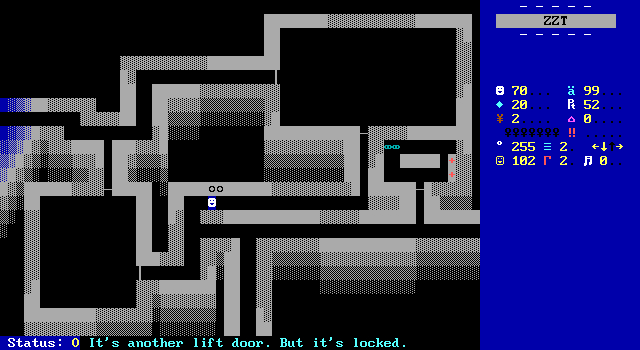
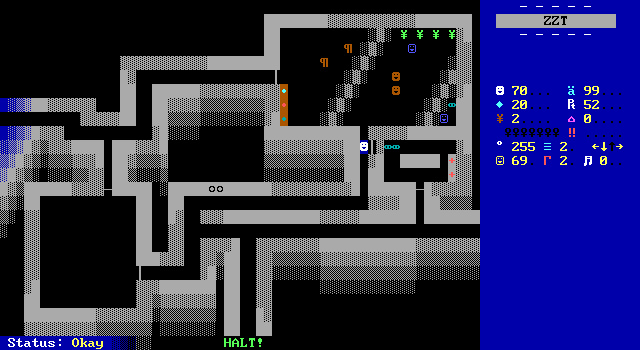
The commitment to unique room designs is another big surprise the game has in store for the player. Again, every room is solid black until a door is opened. It would have been a lot easier for Nadir to create a few pre-fabricated decorations: a potted plant, a table, the remains of a former prisoner. Sprinkle them around the rooms of the fortress and you've got yourself a Wolfenstein 3D level. Yet he continually adds in more unique decorations. While many rooms are basically just a carpet, plant, table, and some guards standing around for no particular reason, there are several which feel a lot more purposeful. Entering a room and revealing scientific equipment indicating a lab, or a kennel filled with dogs and bones. There are pillars and beds. Carpets aren't flat rectangles of a single color and character, but rather composed of multiple colors and simple patterns. Flags appear on walls. The revealed rooms have a level of detail you'd expect typical action board rooms to have. Nadir didn't cut any corners when he gave himself the extra work of having to reveal everything resulting in a very natural feeling engine here that would be capable of tricking somebody new to ZZT into thinking this was just a core feature of the program.
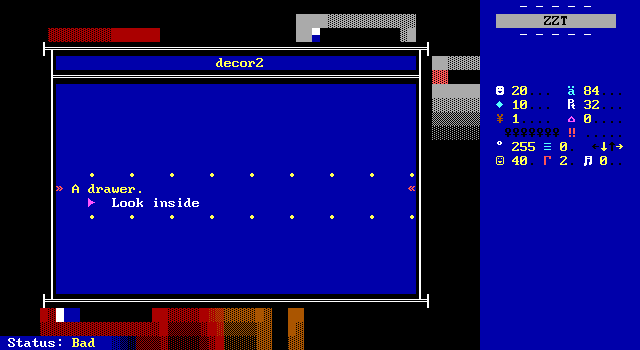
There was always a bit of novelty in early FPS titles that showed the protagonist's face on the bottom of the screen, updating as they get more and more bloodied. ZZT can't do anything of the sort, but Nadir does his best, implementing a little status indicator in the corner of each board. It does nothing for the gameplay, and it's honestly pretty easy to miss since you're going to be looking at your health value and not some text in a corner during a fight, but it helps solidify the game as a love letter to Wolfenstein. At the very least, the player will have time to notice as it updates to "Dead" should a fight prove too difficult.
Including a detailed portrait Cowvitz's face might be a bit too much to ask given the amount of space it would have to take up to not look completely goofy. Instead Nadir applies the physical damage to the player's avatar shown upon completion of a level.
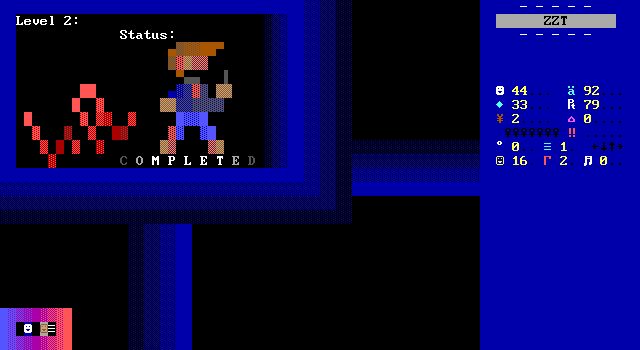
With just a few extra splotches of red, Cowvitz can range from looking slightly dented to being on death's door.
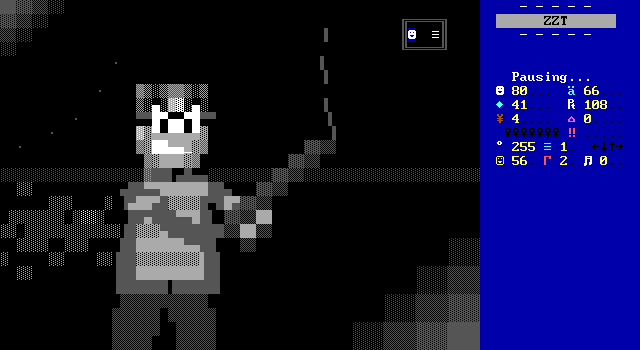
The game's final boss gets hyped up with his own dedicated art board. They don't get a name, but they do get a flamethrower. It's not just for aesthetic either!
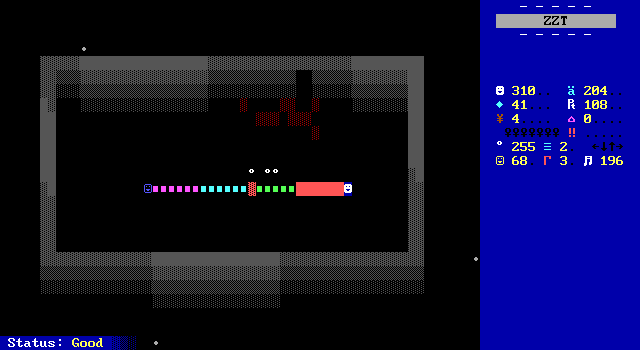
The fight is pretty impressive, but the flamethrower attack definitely steals the show. By #putting a large amount of boulders at once Cowvitz can be burned and pushed far away making it quite the challenge to land shots from such a distance. Thanks to a bit of randomness in the attack patterns, the fight feels engaging and challenging while not overdoing things. Helpfully Nadir quietly dumps a lot of health and ammo on the player just before the fight to make sure it's survivable. Given the challenges of making these one on one fights fun to play, Nadir does quite well here, and I was really surprised to see this unique attack that doesn't rely on bullets, stars, or just coming in contact with the player in a game from 1999!
On The Fritz
The overall experience in Lebensraum is great. In 1999 this is a pretty safe pick for "best ZZT action game", and in the more than twenty years that have passed since, it hasn't fallen all the much (and if you're daring, perhaps at all). The reviews are rather positive save for one issue brought up numerous times that I disagree with. (I'll get into soon enough.) There are still a few bruises here and there worth drawing attention to. It's certainly nothing that leaves a lasting negative impact on the experience, merely some small blemishes that could have been avoided or worked around.
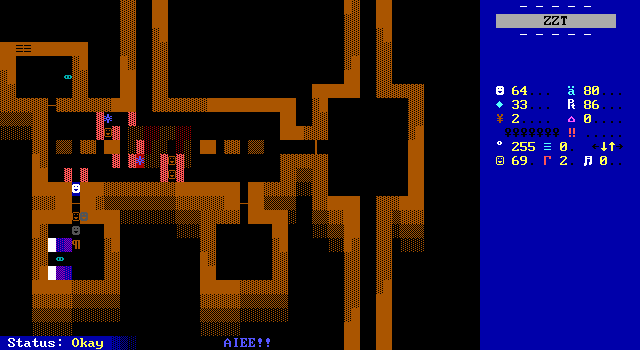
Most of Nadir's code is rock solid, avoiding the likely errors with ease and creating a smooth experience from start to end. The sole exception is in these all too important doors. They behave like countless other object based doors in ZZT, playing a little opening animation and moving in two perpendicular directions. The trouble is that every door has a fake wall nearby for it to open into. The first time you open any door it will work just fine, but once the enemies inside have woken up they might wind up wandering into these secret walls and gumming things up. Usually with a bit of luck or by just moving to a different part of the screen so your enemies movements towards the player are in a different direction. It slows things down and makes the game suddenly feel a lot clunkier.
Depicted here though is the most extreme possibility: An enemy has killed another enemy and blocked the door entirely. While that gray object standing on a fake wall might move if the player was to head towards the southern exit of this board, no matter what the player does though, the door will never be able to be opened. Since corpses can only be cleared by looting them first, these two and their dog are trapped forever. In theory this can happen in quite a number of rooms. "DOOR STUCK!", I believe, is the technical term for this.
The player can mitigate it by running in or blocking the door from closing with their own body. In terms of code, something needs to be done to acknowledge a stuck door. I might imagine allowing them to be destroyed by shooting them which could also help enemies spread out of rooms and chase down a retreating player as they can't open doors themselves. This would have some considerable impact on gameplay though as taking a few shots to destroy a door could encourage players to just open doors by shooting them in the first place from as far away as possible which is not something that would encourage being a "hard man of action".
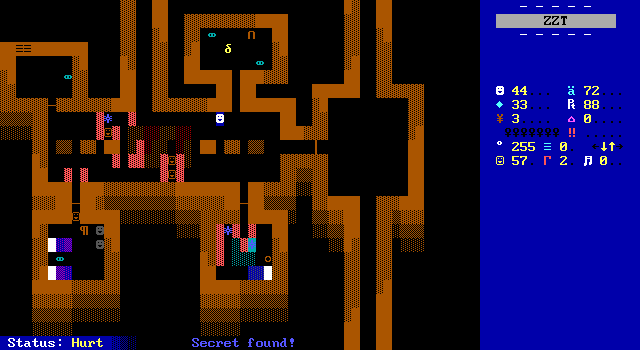
Another issue comes from the under utilization of some of the mechanics. Taking a page from Wolf 3D, the fortress has plenty of collectible treasures and secrets to find. The trouble is that neither are worth finding. Strangely, Nadir is definitely tracking the expected stats. Each treasure gives a gem. Every kill a point, and every secret a torch. At the end of each level though, these stats are never tallied up. Even at the end of the game they still don't get used, save for a strange bonus reward if you collect all the secrets. But if that secret count isn't at its maximum, there's no real feedback provided so while Nadir may encourage the player via text to look for secrets and treasures, there's not much reason to bother.
It's arguably worse with the secrets. Hunting them down in the actual Wolfenstein 3D is already a tedious process of mashing the spacebar while walking at an angle into walls to slide down a room's border and hope to find the right spot. In ZZT, there's no sliding, turning the process into touching a wall, moving to the side, and repeating until you find something.
You can get some advantage in searching by trying to figure out where there's actually space on the board to hide an entire room. but it's just not a fun process. Wolfenstein 3D also tried to at least narrow down the search at times by encouraging the player to see what sticks out. Checking a portrait or statue is a lot faster than going from wall to wall. Subtle color differences could have been used for those give players looking closely at the boards a chance to find secrets without having to try every tile. Give a wall a dark blue background instead of black, or mismatch a tile by using an object with the appearance of black-on-color water instead of color-on-black normal () and you've got something more workable.
Blitzkrieg Gaming
The last issue is the one that I didn't mind, but every review save for one mentions: the game's length. Three levels and a boss certainly doesn't sound like much. In fact, counting the boss fight, there are a mere fifteen boards that the player gets to shoot on. Reviewers wanted more, and I can't really blame them.

Nadir acknowledges this on the end screen himself even. At first, it would seem the culprit is the obvious one: the sheer number of objects necessary to reveal the contents of every room bloats the memory budget. In reality it's a bit more nuanced than that. It is true that there's a lot of optimization that could be done with the code. Decorative objects that could get away with using #BIND per-room don't. This really adds up with the carpets especially as each tile is made by a dedicated object with its own unshared code.
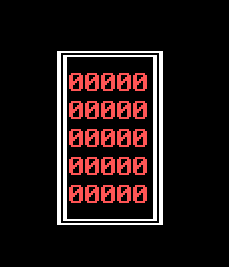
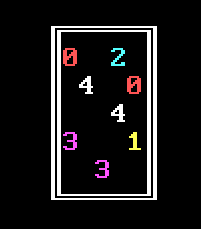
I crunched the numbers here with a theoretical 5x5 carpet. Using Nadir's approach with every object having unique code, this took up 1412 bytes (for the entire board, not just the visible objects here). Adding in #BIND can bring that down to 1295 bytes. However, even this is much more than needed. The ideal approach would be to keep objects to a minimum and have them place fake walls to produce the reset of the floor. In the third image, you can see an arrangement where the objects' characters are how many surrounding tiles they need to place fakes on to cover the area. This brings our carpet down to 870 bytes, nearly 40% in savings!
The carpets in Lebensraum often use STK colors, but this can still be pulled off with ZZT-OOP's limited colors by not specifying a color and instead coloring the empties themselves (which I'm now forgetting if I did for my memory calculations. A more complex carpet pattern would slightly increase memory usage).
So there's some memory saves clearly available. And, let's be honest, I wouldn't miss the "Status: Good" in the corner being removed from every board to free some more space. It's cute, but hardly a core part of the experience. (Admittedly, one of these objects does double duty enforcing the maximum health and ammo as well.)
None of this really matters though as Lebensraum is so self-contained. Nadir mentions not wanting to make additional files, but it was definitely an option. Each file could be an "episode" and nobody would bat an eye at health and ammo being reset at regular intervals, or a password system could be implemented to carry over specifics if preferred.
Despite these possibilities, I feel like Nadir actually picked the smartest option: releasing a finished and polished game. Could Lebensraum benefit from a few more levels? Probably, but what's here still took me a good 50 minutes to get through, which is a perfectly reasonable length. The only reason it feels short is because the game is divided up into discrete levels. When a game is three levels long, that's short. When a game's levels take about 15 minutes each, suddenly things feel a lot longer.
Nadir calling it quits also shows an understanding that as fun as this style of ZZT action can be, it will get repetitive eventually. With all the enemies revealed in the game's first level, doubling the size of the game wouldn't give the player anything they haven't already experienced in the set of levels actually released. Combine that with the admittance of getting bored towards the end, and this is a case of an author who knew when to stop, a skill that was rather rare in the era where every ZZT game had to be bigger and better than the previous. I've run into my share of ZZT games that suffered because they went on for too long. Nadir recognizing Lebensraum had given all it could reasonably give likely plays a big part into why it still plays so well today.
One For The History Books
I don't want to dwell on it, but this Lebensraum is loaded with tidbits of ZZT history of the day. The world includes information on every Reptile House release as well as information on upcoming titles that also make this world one of note for those interested in what the ZZT community was like at the turn of the century. The credits include numerous shout outs and quotes which are just weird enough that I believe them to be legit. As a Nadir game, there are also a few hidden boards, inaccessible and otherwise. The bonus reward for finding all the game's secrets is what I will generously call a "unique mini-game" in which you play as an evil duck and get to talk to and kill everybody in the ZZTer IRC channel of the time, #darkdigital. Were you around back in those days? If so, take a look and see if Nadir depicted your reaction to being shot by a duck.
Again, not relevant to the game itself, but it's a look at some possibly familiar faces speaking in all-caps. It's also purely a cameo board where the objects all have :SHOT labels. It would've been pretty amusing if it was framed as a regular level with the ZZTers shooting back, but then we'd likely be running into some even more sketchy territory than this already is with regards to how such a scene would have aged.
Final Thoughts
Despite a lack of story development, a limited of number of enemies and levels, and some not-quite-finished features in terms of stat calculation, Lebensraum remains a fantastic example of what ZZT action games can be. Action games are some of the easiest to create in ZZT, requiring little more than ammo for shooting and enemies to be shooting which can be done entirely without code. As such, there's a massive number of them out there. As with any creative medium, most of what's there isn't all that impressive, with few games in the genre really feeling special in some way. Lebensraum is definitively one such game. Little else in ZZT's history, even worlds released after Lebensraum can compare. In 1999 this is by far the most impressive action game for ZZT around, and for it to remain mostly unchallenged for so long afterwards shows just how effectively Nadir figured out how to perfect a staple genre of ZZT. This one feels so far ahead of the curve, that I suspect that had it come out even a decade later it still would have turned heads and had much the same reputation that it actually received. Darren Hewer's Death is about the only thing I've seen that comes close, but through Nadir's ability to surprise the player through revelation Lebensraum pulls ahead in the end.
Thanks to its short length, this is one I highly recommend. If you want shooting in ZZT that feels meaningful rather than just shooting fish in a barrel, Lebensraum is one of just a handful of titles that really pull it off. It's a rare feat today, and one that was unprecedented at the time of release. The adjustable difficulty should let most players get through fairly quickly. (I played on "I've played before", and the number of times I died could be counted on one hand.) You'll be wowed by the appearing scenery, impressed by the game's final boss fight, and have a great time shooting your way through the fortress. Lebensraum's reputation has been one that was well-earned. This is a must play for fans of the genre and those looking to play games that left an impact of the ZZT scene.

